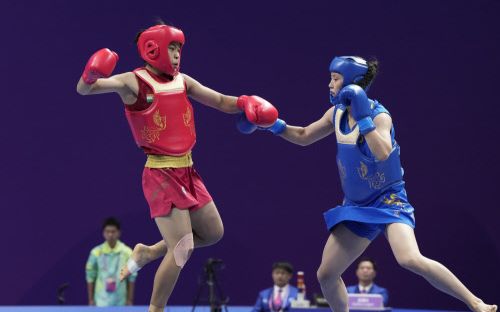
Shuai Jiao (Chinese Wrestling)
Welcome to the Dynamic World of Shuai Jiao: Chinese Wrestling in Wushu
Welcome to the exhilarating realm of Shuai Jiao, where strength meets strategy and technique reigns supreme. Shuai Jiao, also known as Chinese Wrestling, is a traditional martial art that dates back thousands of years, originating from the ancient battlefields of China. In this comprehensive guide, we will explore the origins, principles, techniques, training methods, and competitive aspects of Shuai Jiao, as well as its significance in the world of martial arts.
Origins and Evolution
Shuai Jiao traces its roots back to ancient China, where it was developed as a practical combat system utilized by soldiers, warriors, and martial artists on the battlefield. Drawing upon the principles of leverage, balance, and timing, Shuai Jiao practitioners learned to use throws, sweeps, and takedowns to control and neutralize opponents in close-quarters combat.
Over the centuries, Shuai Jiao evolved into a sophisticated martial art with its own unique set of techniques, rules, and training methods. It became popular among military personnel, law enforcement officers, and security guards for its effectiveness in subduing adversaries without causing significant injury.
Principles of Shuai Jiao
Shuai Jiao is guided by several fundamental principles that govern its techniques and applications:
1. Leverage and Balance:
Central to Shuai Jiao is the principle of leverage, wherein a practitioner uses their opponent's momentum and body mechanics against them to execute throws, sweeps, and takedowns. By disrupting an opponent's balance and exploiting their vulnerabilities, practitioners can overcome larger, stronger adversaries with finesse and efficiency.
2. Timing and Precision:
Timing is crucial in Shuai Jiao, as practitioners must seize opportunities to execute techniques at the precise moment when an opponent is off-balance or vulnerable. Techniques are executed with speed, precision, and decisiveness, with minimal telegraphing or hesitation to maintain the element of surprise.
3. Control and Adaptability:
Practitioners of Shuai Jiao must maintain control throughout a confrontation, constantly adjusting their techniques and strategies based on the dynamics of the encounter. Adaptability is key, as practitioners learn to respond to changes in their opponent's movements, defenses, and tactics with creativity and resourcefulness.
4. Efficiency and Economy of Motion:
Shuai Jiao techniques are designed to be efficient and direct, requiring minimal energy expenditure to achieve maximum effect. Practitioners focus on conserving energy and maximizing the effectiveness of their movements, using leverage, timing, and technique to overcome opponents with minimal effort.
Techniques of Shuai Jiao
Shuai Jiao encompasses a diverse array of techniques, each designed to off-balance, control, and immobilize opponents through throws, sweeps, and takedowns. Some of the most common techniques include:
1. Throws:
Throws are the hallmark of Shuai Jiao, involving the use of leverage and momentum to lift and throw an opponent to the ground. Practitioners execute throws such as hip throws, shoulder throws, leg sweeps, and body locks, utilizing their entire body to generate power and force.
2. Sweeps:
Sweeps are techniques used to off-balance an opponent by sweeping their legs out from under them, causing them to lose their footing and fall to the ground. Practitioners perform sweeps with precision and timing, targeting the opponent's lower body and exploiting their center of gravity.
3. Takedowns:
Takedowns involve taking an opponent to the ground by controlling their upper body or lower body and disrupting their balance. Practitioners execute takedowns such as arm drags, body tackles, and leg trips, using speed and timing to catch opponents off-guard and initiate the takedown.
4. Control Holds:
Control holds are techniques used to immobilize an opponent on the ground and prevent them from escaping or counterattacking. Practitioners apply control holds such as pins, locks, and chokes, using leverage and pressure to maintain control while transitioning to a dominant position.
Training Methods and Practice
Training in Shuai Jiao is both rigorous and disciplined, requiring practitioners to develop strength, agility, timing, and technique. Training methods typically include:
1. Technical Drills:
Practitioners engage in drills to develop proficiency in fundamental Shuai Jiao techniques, focusing on proper form, balance, and timing. Partner drills allow practitioners to practice applying techniques in a cooperative setting, refining their skills through repetition and feedback.
2. Conditioning Exercises:
Physical conditioning is essential for Shuai Jiao practitioners, as it helps develop the strength, endurance, and agility needed to execute techniques effectively. Training regimens may include strength training, cardiovascular exercises, flexibility drills, and functional movement exercises tailored to enhance martial arts performance.
3. Live Sparring:
Live sparring sessions provide practitioners with an opportunity to test their skills against resisting opponents in a dynamic, unpredictable environment. Practitioners engage in controlled sparring matches, applying Shuai Jiao techniques in real-time while developing timing, reflexes, and strategic thinking.
4. Competition and Practice Matches:
Competitive matches and practice sessions allow practitioners to apply their skills in a simulated competition setting, honing their ability to read opponents, anticipate movements, and adapt their strategies on the fly. Practitioners compete in tournaments, matches, and exhibitions to showcase their skills and test themselves against fellow competitors.
Competitive Aspect of Shuai Jiao
Shuai Jiao competitions provide practitioners with the opportunity to showcase their skills and compete against opponents in a controlled, regulated environment. Competitors participate in various weight classes and divisions, with matches typically consisting of multiple rounds of timed action. Judges score bouts based on criteria such as effective throws, sweeps, takedowns, and control holds, with the goal of determining the superior wrestler.
Conclusion
Shuai Jiao stands as a testament to the ancient roots and enduring legacy of Chinese martial arts, offering practitioners a comprehensive system of throws, sweeps, and takedowns for combat, self-defense, and sport. Through its emphasis on leverage, timing, and control, Shuai Jiao empowers practitioners to overcome adversaries with finesse and efficiency, showcasing the timeless principles of martial arts mastery. Join us at the Amature Association of Wushu Hisar as we celebrate the artistry and athleticism of Shuai Jiao, where every throw is a testament to the indomitable spirit of Wushu.